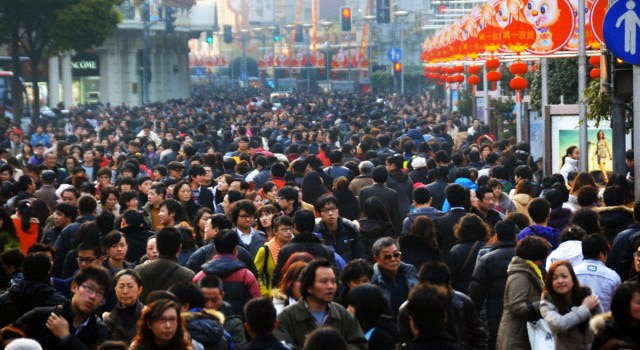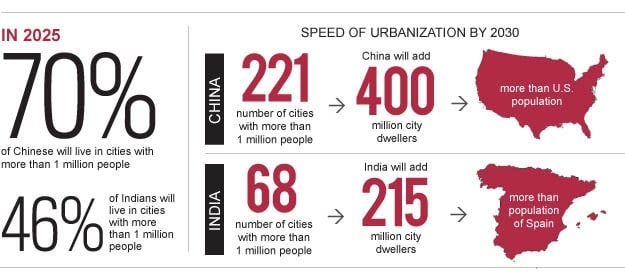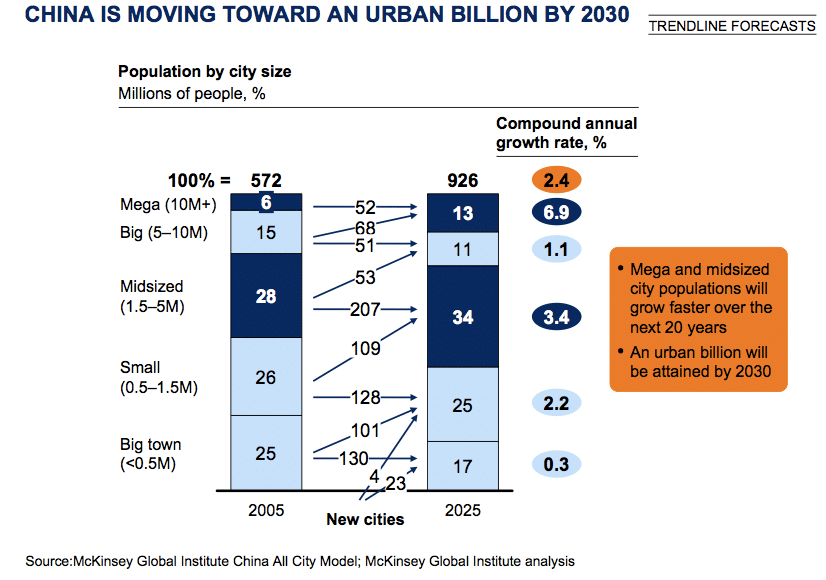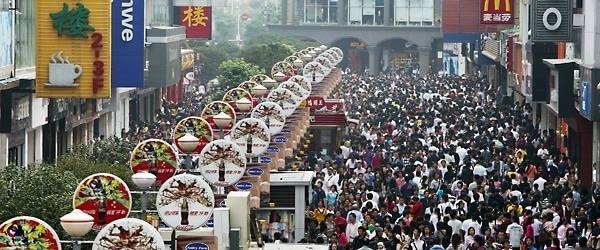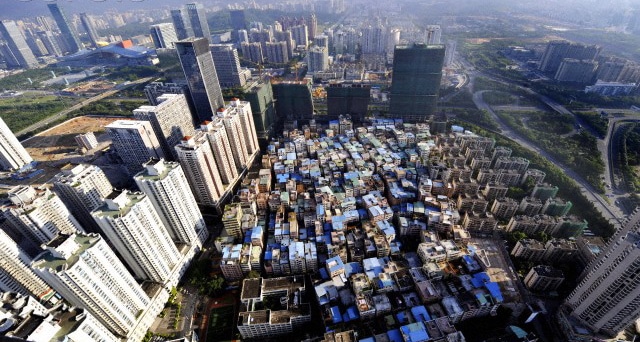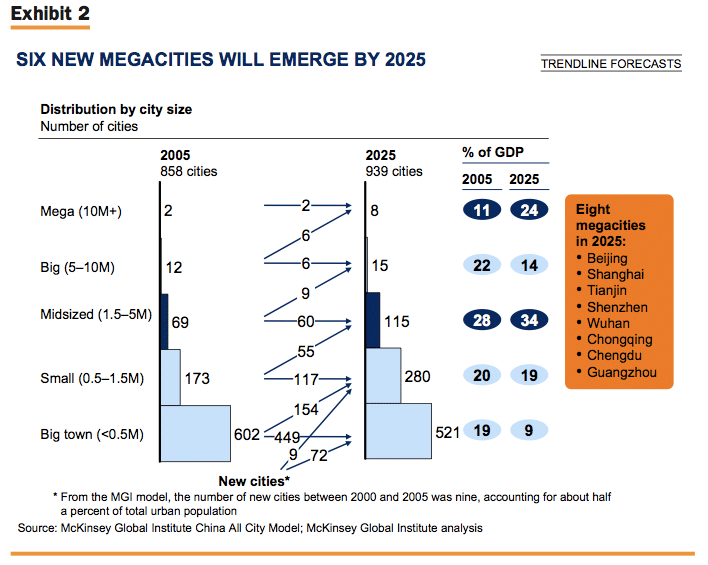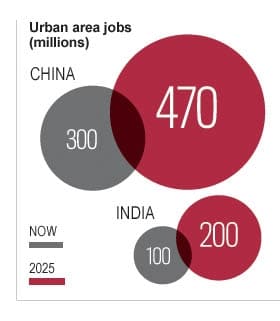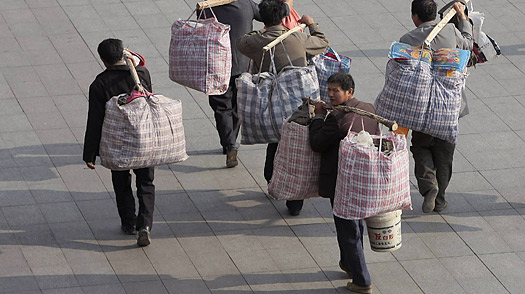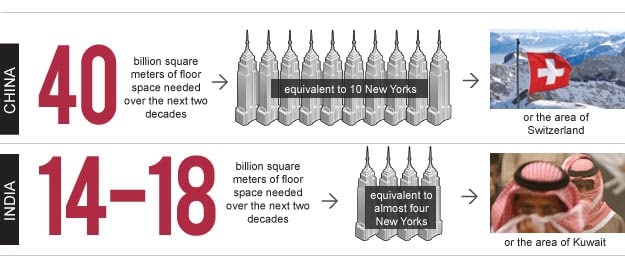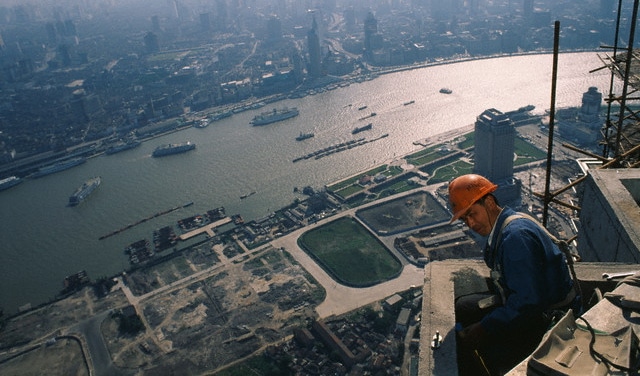Urban development & growth has been a top priority in China’s social and economic plan as well as a huge driver for the overall success of the economy. These are China Mike’s 100% verified, no B.S. facts about the Urbanization, Mega-Cities, and Migrant Workers in China.
China’s urban population: 43% of total population (2008 estimate: CIA World Fact Book)
Rate of urbanization: 2.7% annual rate of change (2005-10 estimate: CIA World Fact Book)
Top 10 most populous Chinese cities: (metro area populations, 2010-2011)
Shanghai (上 海): 18,000,000
Beijing (北 京): 13,200,000
Guangzhou (广 州): 12,000,000
Shenzhen (深 圳): 8,615,000
Tianjin (天 津): 8,200,000
Chongqing (重 庆): 7,500,000
Hong Kong (香 港): 7,055,071
Dongguan (东 莞): 6,950,000
Nanjing (南 京): 6,800,000
Wuhan (武 汉): 6,600,000
[Source: Wikipedia “List of cities in the People’s Republic of China by population”]
Click here for my Chinese major cities and population density maps.
Shanghai was ranked #1 as the best city in mainland China for doing business. The rankings—by the China Regional Forecasting Service (Economist Intelligence Unit)— measures five key areas: economic performance, market opportunities, labor market, infrastructure and environment.
[The Economist “Chinese city rankings: Streets of plenty” Sept. 2, 2008 ]
China facts: URBANIZATION
Two-thirds of China’s population—an estimated 64%—will live in cities by 2025.
[ McKinsey & Co. report “Preparing for China’s urban billion” March 2009 ]
China will add more new city-dwellers than the entire U.S. population by 2025.
McKinsey “projects that China’s urban population will expand from 572 million in 2005 to 926 million in 2025…by 2030, China’s urban population is on track to reach one billion.” Of those 350 million people, they estimate that more than 240 million will be migrants.
[ McKinsey & Co. report “Preparing for China’s urban billion” March 2009 ]
China only had 172 million urban residents in 1978 (when Deng Xiaoping started economic reform). By 2006, this number mushroomed to 577 million urbanites.
[National University of Singapore & University of Hong Kong, “City-industry Growth in China”, May 2010 ]
Between 1990 and 2005, an estimated 103 million Chinese people migrated from rural to urban areas.
[ McKinsey & Co. report “Preparing for China’s urban billion” March 2009 ]
By 2015, China’s urban population is expected to exceed 700 million…marking the first time China’s urban population will surpass its rural population.
[ China’s National Population and Family Planning Commission, July 2010 ]
Revenue from land-rights sales makes up about 46% of all local-government revenue. “Chinese cities make ends meet through land-grabs. Property on the edge of town is bought, using compulsory-purchase orders that seldom pay the landowners properly, and then sold to developers, who sell on the houses they build to the richer urban middle classes.”
[ The Economist “A work in progress” March 17, 2011 ]
China facts: GROWTH OF THE MEGA-CITIES:
China will have an estimated 221 cities with a population of a million or more by 2025. Today, Europe only has 35 such cities.
[ McKinsey & Co. report “Preparing for China’s urban billion” March 2009 ]
China will have an estimated 23 cities with a population of 5 million or more by 2025.
[ McKinsey & Co. report “Preparing for China’s urban billion” March 2009 ]
China will have an estimated 8 “mega-cities” (populations of 10 million+) by 2025. Two of those will have populations of over 20 million.
[ McKinsey & Co. report, “Preparing for China’s urban billion” March 2009 ]
China facts: MIGRANT WORKERS:
In 2010, China’s rural per capita net income ($758 a year) was less than a third of its urban equivalent—the worst showing since China’s market reforms began in 1978, according to state-run media.
[ Newsweek “China’s Great Divide” April 2, 2010 ]
Q: How many million Chinese live on less than $1/day? The answer in China facts: INEQUALITY, RICH & POOR.
China currently has about 145 million migrant workers (or about 11 percent of China’s total population in 2010)…larger than the entire workforce of the United States.
[“China Development Report 2010: Promoting the human development strategy of China’s new cities,” China Development Research Foundation ]
60 percent of China’s 145 million migrant workers were born in the 1980s or 1990s.
[ China’s Ministry of Human Resources and Social Security ]
225 million rural-born migrant workers—one fifth of China’s population—work in urban areas but are denied benefits enjoyed by city dwellers, which has resulted in “a metastasizing underclass of rural migrants living as second-class citizens in China’s cities…the divide has sparked anger among the rural poor.”
[ Newsweek “China’s Great Divide” April 2, 2010 ]
China has 20 million children of migrant workers living in cities. Many attend unofficial schools set up by migrant workers. Beijing has about 200 migrant school and Shanghai has nearly 300.
[China’s National Committee on Children and Women; China Daily, “Blooming Flowers” June 1, 2010 ]
Out of Shenzhen’s population of more than 14 million people, only 2.5 million are residents. “These ‘black’ workers and their children are not entitled to health care, education or pensions in the city because their hukou (residence registration) is elsewhere.”
[ The Economist “A work in progress” March 17, 2011 ]
China facts: CONSTRUCTION & SKYSCRAPERS
China spends $116 per capita on capital investments in urban infrastructure annually…compared to only $17 in India, according to McKinsey & Co., which wrote that “China has a mature urban-planning regime…consistent with long-range plans for land use, housing, and transportation.”
[ McKinsey & Co. “Comparing urbanization in China and India” July 2010 ]
China will build enough skyscrapers to fill TEN New York-sized cities by 2025.
“[By 2025,] 40 billion square meters of floor space will be built…requiring the construction of between 20,000 to 50,000 new skyscrapers (buildings of more than 30 floors) — the equivalent of ten New York Cities.”
[ McKinsey & Co. report “Preparing for China’s urban billion” March 2009 ]
In 2008, six of the world’s 10 tallest buildings constructed were in China, including the Shanghai World Financial Center, which, at 492m tall, will be surpassed by the 632m Shanghai Center, 632 meters and the 600m Goldin Finance 117 in Tianjin.
[Source: Jonathan Watts, The Guardian, UK May 27, 2009]
The Pearl River Tower in Guangzhou is being billed as “the most energy efficient super skyscraper ever built”. With wind turbines, solar panels, sun-shields, smart lighting, water-cooled ceilings and state-of-the-art insulation, the 310m tower is designed to use half the energy of most buildings of its size and set a new global benchmark for self-sufficiency among the planet’s high rises.
[Source: Jonathan Watts, The Guardian, UK May 27, 2009]
China became the world’s largest construction market in 2010. By 2020, China is predicted to account for one-fifth of the global construction industry (up from current 14%).
[The Global Construction 2020 report, March 2011 ]
NEXT: China Facts: INFRASTRUCTURE & ROADS >>
Return to Facts about China home page

